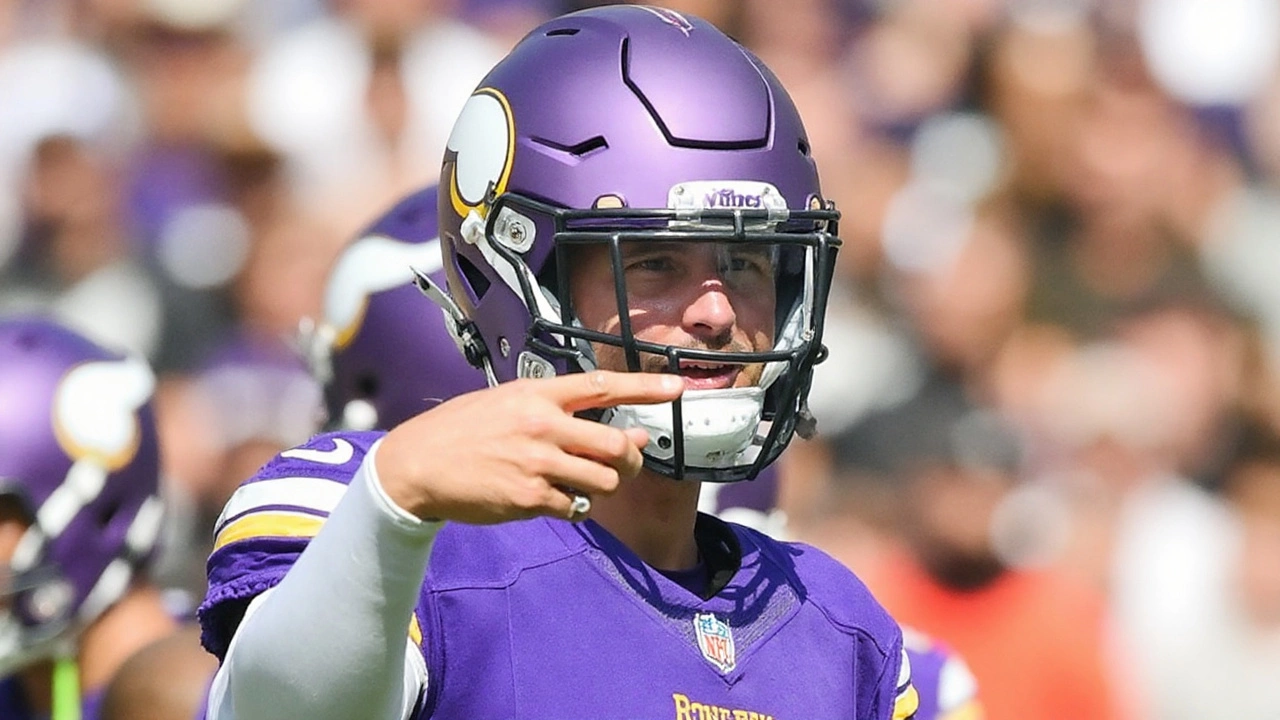Primetime opener becomes a quarterback showcase after a rocky start
The Vikings trailed on the road, their rookie looked rattled, and Soldier Field was roaring. Then, in a span of minutes, the whole night changed. Minnesota beat Chicago 27-24 on Monday Night Football thanks to a furious fourth-quarter rally from J.J. McCarthy, who turned an anxious debut into a statement.
This was McCarthy’s first real NFL game after a long wait. Drafted 10th overall in 2024, he missed that entire season with a knee injury he suffered in his first preseason series. His return came under the lights, in a rivalry game, against the No. 1 pick from the same draft on the other sideline. The setup was made for drama, and it delivered.
For three quarters, it looked rough. Timing was off. Throws sailed. Drives sputtered. Chicago’s pass rush squeezed the pocket, and the rhythm Kevin O’Connell wanted just wasn’t there. You could feel the tension in every snap. This wasn’t college anymore. This was Soldier Field, and the Bears smelled blood.
Still, O’Connell never blinked. He told McCarthy at halftime, “You are going to bring us back to win this game.” Coaches say things like that all the time. What made this different is that McCarthy made it real. The fourth quarter broke open, and the offense shifted into a faster gear. The ball came out quicker. Minnesota leaned on motion, boot action, and the quick game. The rookie settled down and ripped through Chicago’s coverages.
He threw two touchdowns in the final period and punched in a rushing score, flipping the result and the tenor of his night. That late surge didn’t erase the early stumbles, but it reframed them. It said: the stage didn’t swallow him. He learned on the fly, then finished the job.
Across the field, Caleb Williams looked the part, too. Chicago’s second-year quarterback scored his first rushing touchdown and added a passing score in Ben Johnson’s coaching debut. Williams’ arm talent and mobility showed up on designed keepers and off-script plays. When the Bears spread the field and moved the pocket, he punished soft spots and extended drives. The difference was late-game execution.
Chicago had chances to close it out, but Minnesota’s defense came up with just enough. A couple of third-down stops, tighter coverage in the red zone, and a pass rush that finally moved Williams off his spot at the worst moments for the Bears. Complementary football, the kind coaches preach, arrived just in time.
For the Vikings, the meaning runs deeper than a single road win. McCarthy’s wait-and-work year after the knee injury was a test of patience for the front office and the locker room. Nights like this validate the bet. You don’t draft a quarterback in the top 10 only for traits. You draft him for moments when everything feels heavy and he steadies it.
McCarthy’s Michigan résumé—calm in big games, efficient, unbothered by noise—was the sales pitch. That version didn’t show up until the fourth. When it did, you saw why Minnesota stuck with him. He took easy throws without forcing hero balls, used his legs when space opened, and trusted his playmakers to win one-on-ones. The offense finally felt connected.
O’Connell also deserves credit for the pivot. Early on, the Vikings asked McCarthy to hang in the pocket and read full-field concepts. After halftime, they simplified. Quicker reads. Defined throws. More under-center play-action to move the launch point. Those tweaks cut down hits, calmed the pocket, and let the rookie stack completions. Coaching matters most when it adapts to the night, not the notebook.
For Chicago, there’s frustration, but not despair. Williams showed why he was the top pick. He handled pressure, bought time, and kept the Bears in front for most of the game. Ben Johnson’s offense showed an identity: tempo when needed, motion to sort coverages, and run-pass options that suit Williams’ skill set. That’s a decent foundation. The Bears’ issue was closing. Two or three plays swing this result, and Minnesota made them.
Primetime can warp perception. A bad start becomes a narrative. A great finish becomes a promise. The truth sits in between: McCarthy has plenty to clean up—footwork under pressure, ball placement on outbreakers, and speeding through progressions when defenses disguise safeties. But the fourth quarter is what teammates will remember in the huddle. Trust builds fast when a quarterback delivers with the clock ticking.
In the bigger NFC picture, this game nudges both teams onto their early-season paths. The Vikings leave with a road win, a rookie quarterback with proof he can recover mid-game, and a coaching staff that showed flexibility. The Bears leave with evidence their young core can compete, a quarterback who produced touchdowns in two ways, and a head coach whose plan created chances. In a league where September often looks messy, both teams flashed reasons to believe.
If you’re looking for turning points after halftime, a few themes stand out:
- Tempo and spacing: Minnesota used faster pace and spread formations to stop Chicago from rotating late and disguising pressures. That helped McCarthy identify his answers pre-snap.
- Defined reads: More play-action and quick hitters gave the rookie a clear “if-then” menu. When the flat defender widened, he took the stick route. When safeties sunk, he worked the crosser.
- Quarterback run threat: The designed keeper near the goal line forced Chicago to respect the edge, which opened interior run lanes the rest of the quarter.
- Situational defense: The Vikings tightened on third-and-medium and in the red zone down the stretch, forcing Williams to make low-percentage throws outside the numbers.
There were quiet contributions, too. Protection wasn’t perfect, but the line held up better late, especially on the edges. Minnesota’s receivers fought through contact on timing routes to keep the passing game on schedule. The run game did just enough on early downs to hold the Bears’ linebackers in place on play-action. Those small wins add up when a quarterback is finding his feet.
Context matters for McCarthy’s arc. He hadn’t taken a meaningful snap since that Michigan title win over Washington at the end of 2023. A year is a long time for rust to build and confidence to drift. Many young quarterbacks never quite reclaim the easy rhythm they had in college. That’s why the fourth quarter mattered. It wasn’t just production. It was proof he could shake off three bad quarters and still command the moment.
From the Bears’ view, the night wasn’t wasted. Williams’ first rushing score is more than a box-score note. It forces future opponents to prepare for quarterback keepers in the red zone and on third-and-short. That unlocks constraint plays—pop passes, backside slants, bootlegs—that Johnson can layer in as the season goes. Chicago also showed discipline with penalties and a willingness to take calculated shots when Minnesota rolled safeties. The pieces are there.
What’s next? For Minnesota, the task is bottling the fourth-quarter identity and starting faster. That means early scripted plays tailored to quick completions, a couple of easy movement throws to settle McCarthy, and a running script that stays ahead of the sticks. For Chicago, it’s about late-game answers: a two-minute menu Williams can execute without hesitation, and protection plans that hold up when defenses pin their ears back in the fourth.
One more layer is psychological. Young quarterbacks hear everything—broadcast chatter, social media takes, sideline body language. A bad first half can snowball. The halftime message from O’Connell cut through the noise. It wasn’t flowery or complex. It set the standard and transferred ownership to the quarterback. McCarthy responded. That’s a seed you can water in Week 2, Week 10, and beyond.
The opener also reminds us how narrow the margins are at this level. A missed tackle flips a drive. A tipped pass changes field position. A well-timed blitz hides a coverage weakness. Both teams hit those moments. Minnesota hit them last. That’s why the flight home feels different for the Vikings than the walk to the locker room for the Bears.
And for all the talk of arm talent and scheme, there’s a simple takeaway: resilience travels. Minnesota had it when the game tightened. Chicago will need to grow it as the schedule hardens. Nights like this can harden a team or haunt it. We’ll find out which way each locker room leans soon enough.

What the first quarter told us
The opening frame looked like a cautionary tale for a rookie coming off a lost year. The ball came out late. Reads were a beat slow. A couple of miscommunications with receivers stalled drives. Chicago’s front won early downs, forcing long third downs that let the Bears tee off. You could see McCarthy trying to play perfect, aiming throws instead of ripping them.
It wasn’t just him. A false start put Minnesota behind the chains, and a missed assignment let a free rusher through. The route spacing on a third-and-long invited a checkdown short of the sticks. Those details tell a story of a unit still calibrating to live speed. It’s normal in Week 1, but in primetime it looks louder.
Here’s the twist: the first quarter also planted the seeds for the comeback. O’Connell and his staff banked what Chicago wanted to do—rotate late, crowd the middle on passing downs, and attack protections with simulated pressures. The Vikings used that information after halftime to change the picture for the defense and give McCarthy clearer answers.
That’s how you go from a nightmarish start to a defining finish. The adjustments fit the quarterback, the quarterback trusted the plan, and the plan stressed the defense. The Bears got the debut they wanted from Williams for most of the night. The Vikings got the ending they needed from their rookie. On a Monday in Chicago, that was the difference.




Write a comment